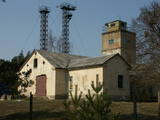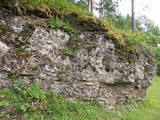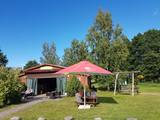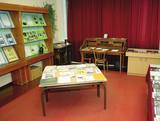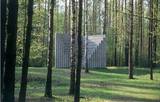| Nr | Nosaukums | Apraksts |
|---|---|---|
|
Pēc aculiecinieku stāstiem, padomju laikā līdz Kolkasragam (jūrai) bija iespējams aiziet tikai robežsargu pavadībā atsevišķos gadījumos. Padomju krasta robežapsardzības postenis atradās Kolkas ciemā - vietā, kur tagad izvietoti Latvijas Krasta apsardzes spēki. Objekts civilām personām ir nepieejams. Attēlā - objekts nr. 30004, kas tāpat kā Kolkasrags un piekraste kopumā bija robežsargu rūpīgi apsargāta.
|
||
|
Upes tecējuma ziņā – straujš un vietām krāčains Gaujas posms starp Vidagu un Vecpalsas ieteku, kura (un kura pieteku) krastos vietām sastopami dolomīta atsegumi, no kuriem lielākie ir Randatu klintis. Liegums veidots g.k. dažādu mežu, pļavu un ar atsegumiem saistītu biotopu aizsardzībai. Arī no ainaviskā un ūdenstūrisma viedokļa – interesants Gaujas vidusteces posms. Izveidoti labiekārtojuma elementi Randatu klinšu apskatei u.c. Teritorija ietilpst Ziemeļgaujas aizsargājamo ainavu apvidū (sk. sadaļu "Aizsargājamo ainavu apvidi").
|
||
|
Atpūtas vieta Braslas upes krastā, kurā pieejamas telts un kemperu vietas. Tiek piedāvātas dažādas izklaides iespējas: laivu noma, meža futbols un meža biljards. Piedāvājumā arī grila noma un malka ugunskuram. Sadarbībā ar kafejnīcu "Zem ozola" tiek nodrošināta ēdināšana, iepriekš par to vienojoties. |
||
|
Kādreizējais tanku poligons, par kuru mūsdienās vairs vēsta tikai netiešas liecības (sk. stāstu).
|
||
|
Ezeres kultūrvēstures un novadpētniecības materiālu krātuve “Muitas nams” ir izveidota vēsturiski nozīmīgā ēkā, kur, II pasaules kara noslēgumam tuvojoties, 1945. gada 8. maijā tika parakstīts Kurzemes katlā ielenkto vācu karaspēka daļu kapitulācijas akts. Ar to tiek uzskatīts, ka Ezerē faktiski beidzies II pasaules karš. Krātuves materiālu ekspozīcijas ir no Ezeres pagasta senvēstures līdz šodienai, tai skaitā ezernieku vaļasprieki. |
||
|
Mūsdienās redzamā vēsturiskā apbūve ap veco Tirgus laukumu ir veidojusies pēc 1881. g. ugunsgrēka. Kandavai raksturīgo pilsētvidi veido sētas ar saimniecības ēkām, noslēgtiem pagalmiem, caurbrauktuvēm un laukakmeņu mūriem. Tas aplūkojams Talsu un Sabiles ielās. Latvijas ainavai neierasta ir arī Lielā iela. Bruņinieku pilskalna piekājē ir apskatāms nesen (2010. g.) izveidotais Livonijas ordeņa pils makets. |
||
|
Kalifornijas sarkano slieku audzēšana un biohumusa ražošana. Piedāvā nelielu ekskursiju ražotnē, informāciju par slieku audzēšanu un biohumusa ražošanu. |
||
|
Dodieties ekskursijā, lai gūtu ieskatu lauku profesijā un dzīvesveidā, kā arī iegūtu jaunus iespaidus un labu atpūtu visai klasei. Ekskursijas laikā apmeklējiet mini zoo, kur apskatāmas aitas, kazas, Ķīnas lielās cūkas, truši, dažādi eksotiskie dzīvnieki un putni. Bērniem īpašu prieku sagādā saskarsme ar mājdzīvniekiem un Japānas makaka – pērtiķa Nilsona izdarības. Pēc tam apmeklējiet zemnieku saimniecību, kurā izveidots atrakciju parks ar vairāk kā 20 atrakcijām 3,5 hektāru platībā. Ekskursijas noslēgumā dodieties uz atpūtas kompleksu pašā Zemgales sirdī, lai apskatītu vējdzirnavas un izceptu paši savus pīrāgus. |
||
|
Kā vēsta sens nostāsts, pirmās baznīcas laikā, kad vētrā noticis dievkalpojums un pie vecajiem kapiem jūrā grimis kuģis, mācītājs ar draudzes locekļiem – brīvprātīgajiem devies airu laivā glābt kuģa komandu. Daļu no tās izdevās izglābt, bet pārējos izskaloja krastā. Godinot no vienas puses traģisko, bet no otras – laimīgo notikuma atrisinājumu, kuģa kapteinis šo vietu nosauca par Feliksbergu jeb laimīgo krastu. To vēlāk nomainīja Pilsbergas nosaukums, bet tagadējo nosaukumu – Jūrkalne apdzīvotā vieta ieguva 1925. gadā. |
||
|
Udmurdu un citu somugru nacionālo ēdienu meistarklašu rīkošana, citu tautu kultūras apgūšana caur ēdienu. |
||
|
Zemnieku saimniecība „Kronīši” atrodas Limbažu novada Viļķenes pagastā. Saimniecībā tiek audzēti bioloģiskie dārzeņi, kas tiek pārstrādāti dažādos mājas konservos. No bioloģiskajām pļavām vāktiem augiem tiek ražotas tējas, piedāvājumā arī ievārījumi, konservi, sīrupi un sulas. Augļi un ogas tiek ievākti no pašu dārza, kā arī no vietējiem zemniekiem un blakus esošā Rūstužu un Blomes purva. Saimniecībā uzņem tūristu un pieredzes apmaiņas grupas ar iepriekšēju pieteikšanos. Ģimenes pasākumiem, t.sk. bērnu ballītēm, radošām darbnīcām un citām aktivitātēm pieejams tējas namiņš. |
||
|
Jaunais un modernais koka skatu tornis atrodas Tērvetes dabas parka rietumdaļā. No tā paveras skats uz plašajiem Tērvetes siliem, Tērvetes upes ieleju un Zemgales līdzenuma lauksaimniecisko ainavu. Tornis atvērts laikā no marta vidus līdz novembra vidum. Maksas ieeja. |
||
|
“Gustiņš” ir ģimenes uzņēmums, kas kopš 2002. gada Alūksnes novada Jaunannas pagastā nodarbojas ar dažādu kulinārijas izstrādājumu ražošanu, piedāvājot saviem pircējiem vairāk nekā 20 veidu gaļas rolādes, ruletes un citus gaļas izstrādājumus, kā arī 50 veidu salātus. Turpinot augt un attīstīties, 2011. gadā izveidota kūpinātava un uzsākta arī mājas kūpinājumu ražošana, kā arī atvērta kafejnīca “Gustiņš”, kuras piedāvājumā tūrisma sezonā vai pēc pasūtījuma ir arī Alūksnes novadam raksturīgie Malēniešu ēdieni. 2017. gada pavasarī “Gustiņa” sortimentu papildinājuši dažādi konditorejas izstrādājumi, no kuriem noteikti jāpiemin “Gustiņa” Kūciņas burciņā. Katru gadu pirms Ziemassvētkiem, jau sākot no novembra, pircējiem ir iespējams iegādāties un pasūtīt arī gardās un īpaši dekorētās “Gustiņa” piparkūkas. Visa produkcija tiek gatavota ar rokām gan pēc senām vecmāmiņu, gan mūsdienu receptēm, un cik vien iespējams izmantojot Latvijas zemnieku un vietējo ražotāju audzētās izejvielas un tikai dabīgās garšvielas. Ražošanā netiek izmantoti pārtikas uzlabotāji. Visu “Gustiņa” ražoto produkciju var iegādāties kulinārijas veikalā “Gustiņš” (Alūksnē, Tirgotāju ielā 10), kurā tiek piedāvāti arī citi kvalitatīvi un interesanti Latvijas ražotāju produkti. |
||
|
Daiļdārzs meklējams Daudzevas ciema ziemeļdaļā, aptuveni 0,3 km ziemeļrietumos no Daudzevas dzelzceļa stacijas. „Gundegu” māju saimniece savā īpašumā ir izveidojusi skaistu un ainavisku daiļdārzu, kurš izplānots vairākās, savstarpēji telpiski nošķirtās daļās, kurās aug krāšņumaugi, skujeņi, ogulāji un augļkoki. Savukārt, siltumnīcās gatavojas arbūzi, tomāti, paprikas un citi dārzeņi. Apmeklētāji saimnieces pavadībā var iepazīt dārzu, atpūsties lapenē, bet īpaši interesenti – saņemt vērtīgu padomu un kādu stādu. |
||
|
No Rīgas dodieties gar Daugavas labo krastu un apciemojiet Trušu Karalisti, kurā trušu mājiņas ir veidotas kā mazas muižas un pilis. Pēc tam dodieties uz Skrīveriem nogaršot mājas saldējumu un apmeklējiet Kokneses pilsdrupas. Nākamajā dienā apmeklējiet privātu mini-zoo ar dažādiem eksotiskajiem dzīvniekiem, pēc tam dodieties uz Raunas cepli, lai redzētu, kā top dažādi māla priekšmeti no sākuma līdz beigām. Vērts apskatīt Cēsis un tās viduslaiku pili. Izstaigājiet Līgatnes dabas takas, kur iespējams redzēt vairākus vietējos savvaļas dzīvniekus. Siguldā bērniem patiks piedzīvojumu parks. Siguldā atrodas arī divas viduslaiku pilis. Pirms atgriešanās Rīgā, apciemojiet zemnieku saimniecību, lai apskatītu kazas, ponijus u.c. dzīvniekus, kā arī nogaršotu kazas piena piena produktus. |
||
|
The tour from Rīga to Tallinn combines natural and cultural heritage and includes lovely landscapes and 15 nature trails which cross marshlands, meadows and forests along the shores of the Baltic Sea, including several protected nature reserves. Many trails are equipped with viewing towers for birdwatching. Randu meadows near Ainaži contains one third of Latvia’s entire plant species. A boardwalk leads through reeds to a viewing platform with views over the meadow and the sea. Saaremaa island is interesting with very different natural attractions to the mainland - dolomite cliffs, juniper heaths, a meteorite lake and rocky sea shore. The tour passes rural farms and traditional villages typical of the coastal areas. Hiiumaa island is a laid back place and retains a very Estonian atmosphere with an important bird reserve at Käina Bay, unusual Sääre Tirp as well as several small islets off its south-eastern coast. Back on the mainland, Paldiski peninsula gives a glimpse of the recent history with its former Soviet military base |
||
|
Kafejnīca "Stieres" atrodas Jūrmalas – Kolkas ceļa (P 131) malā – kempinga „Stieres” teritorijā. Piedāvā mājas virtuvi visām ēdienreizēm. Maltīti gatavo no Latvijas zemnieku audzētiem dārzeņiem, salātiem, zaļumiem. Zivju ēdieni ir no vietējo zvejniecības uzņēmumu ķertā vai pārstrādātā loma. Piedāvā dažādu svinību galdu klāšanu. Latviešu virtuve: Aukstā zupa, siļķe ar kartupeļiem un biezpienu, kartupeļu un plānās pankūkas, rosols, vietējo zemeņu zupa.
|
||
|
Bērzgales novadpētniecības muzejs dibināts 1988. gadā. Tajā
iekārtota rakstnieka Antona Rupaiņa (1906 – 1976) piemiņas istaba,
ekspozīcija par pagasta vēsturi, tā ievērojamiem cilvēkiem un
kultūrvēsturiskajām tradīcijām.
Darba laiks: P. - Piekt: 9.00 – 12.00,13.00 – 17.00, S., Sv : pēc pieteikuma |
||
|
Dibināts 1959. gadā., 60 skujkoku un 350 lapu koku sugas.
Lāčupītes krastos starp Tukuma – Kolkas ceļu un jūru krasta kāpās atrodas dendrologa Igora Medņa veidotie svešzemju koku un krūmu stādījumi. I. Mednis veica eksperimentus un pētīja - kā vietējiem apstākļiem pielāgojas un aklimatizējas dažādas svešzemju augu sugas. Te vērts ierasties maijā un jūnijā, kad zied rododendri.
|
||
|
Eiropas centra muzejs. 1991. g. dibinājis Lietuvas tēlnieks Gintaras Karosas. Brīvdabā izstādītas > simts 33 pasaules valstu mākslinieku radītās instalācijas. |
||
